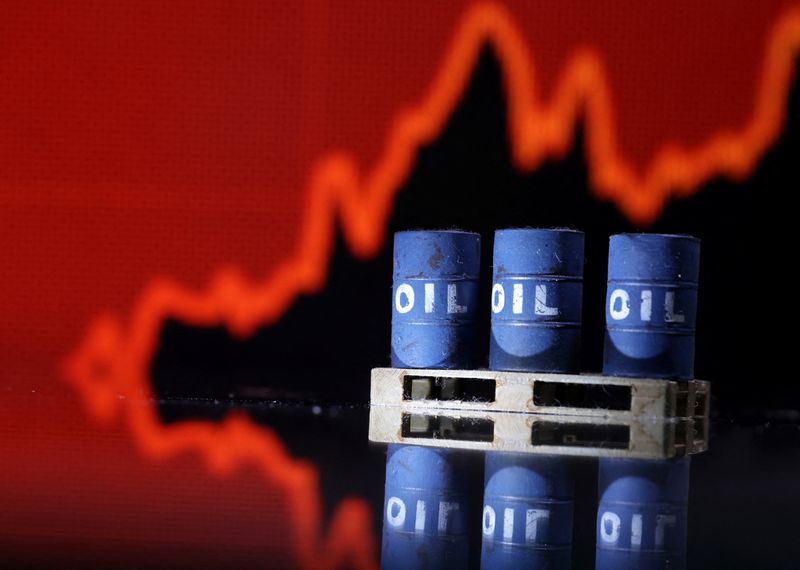By John Kemp
LONDON (Reuters) -U.S. manufacturers are gradually emerging from a prolonged but shallow slowdown over the last two years, but progress has been fitful, and their consumption of diesel remains tepid, which is weighing on oil prices.
The Institute for Supply Management's manufacturing index slipped to 48.7 (22nd percentile for all months since 1980) in May from 49.2 (26th percentile) in April and a recent high of 50.3 (34th percentile) in March.
The March reading was the first time the index had climbed above the 50-point threshold, signalling expansion, since October 2022, but it has since slipped back into contraction territory for the last two months.
The survey's production sub-index fell to 50.2 (21st percentile) in May from a recent high of 54.6 (45th percentile) in March, as activity rates faltered.
Indicating the expansion could remain desultory for a few more months, the new orders component slumped to 45.4 (9th percentile) in May from 51.4 (27th percentile) in March.
Chartbook: U.S. manufacturing and diesel use
Manufacturers reported weaker conditions than their counterparts in services, real estate, construction, mining and farming.
The ISM non-manufacturing index actually rose to 53.8 (33rd percentile for all months since 1997) in May from 51.4 (14th percentile) in March.
Manufacturing provides fewer jobs and accounts for a smaller share of overall economic output but is much more energy-intensive.
By contrast, services account for a far larger share of value-added, employ more people but use relatively less fuel and electricity.
The manufacturing sector's sluggish performance has therefore dampened overall energy consumption – even as the faster growth in services has boosted the overall economy and employment.
Expectations at the beginning of the year that an acceleration in manufacturing in the United States and the other major economies would lift diesel consumption and prices have not been realised.
DISTILLATE FUEL SLUMP
More than three-quarters of all diesel and other distillate fuel oils are used in freight transport, manufacturing and construction, so distillate consumption is normally correlated closely with the manufacturing cycle.
But consumption of distillates has been even more lacklustre than the slow and halting recovery in manufacturing activity over the last six months.
The volume of distillate fuel oil supplied to the domestic market, a proxy for consumption, was under 3.7 million barrels per day (b/d) in March 2024.
Volumes supplied were the lowest for the time of year since 1998, according to estimates prepared by the U.S. Energy Information Administration.
Volumes were down by 10% compared with the same month last year and by the same percentage compared with the prior 10-year seasonal average.
Supply can be volatile from one month to the next. March may have been an outlier. But distillate consumption has been lagging the upturn in manufacturing for several months.
Some petroleum-derived distillate fuel oils are being replaced by biodiesel and renewable fuel oils, especially in California.
Even if biodiesel and renewable fuel oils are included, however, the volume of distillate supplied was down by 4-8% in March compared with last year and the 10-year average.
Total petroleum and non-petroleum distillates supplied were the lowest since the first wave of the pandemic in March 2020 and before that the mid-cycle slowdown in March 2016.
Total distillates supplied have been broadly flat over the past 12 months despite the reported improvement in manufacturing and freight activity.
DISTILLATE INVENTORIES
Reflecting tepid consumption and strong refinery crude processing to make gasoline, distillate stocks have been trending higher for the last three months.
Inventories were still 10 million barrels (-8% or -0.52 standard deviations) below the prior 10-year seasonal average on May 31, according to data from the EIA.
But the seasonal deficit had narrowed from 18 million barrels (-13% or -1.09 standard deviations) at the start of March.
Stocks have been flat or increasing at a time of year when they would normally be depleting and have climbed to a four-year seasonal high.
In response, prices for diesel other distillates have been falling faster than for crude, narrowing the gross refinery margin or crack spread.
The crack spread for making diesel from Brent crude has narrowed to an average of just $19 per barrel so far in June 2024.
The inflation-adjusted spread has narrowed from $46 per barrel as recently as August 2023 and a record $63 in June 2022 after Russia's invasion of Ukraine.
In real terms, the spread has fallen back in line with the average for the five years between 2015 and 2019 before the pandemic and invasion.
Traders expect diesel supplies to remain plentiful for the next few months, which should help contain inflationary pressures within the supply chain and give the major central banks more scope to trim interest rates.
Related columns:
- Renewable fuels take bite out of US diesel consumption (May 10, 2024)
- U.S. manufacturers emerge from slump, set to boost fuel use (April 4, 2024)
- Global freight acceleration will lift fuel prices (March 27, 2024)
- Diesel prices primed to rise sharply in 2024 (February 6, 2024)
John Kemp is a Reuters market analyst. The views expressed are his own. Follow his commentary on X
